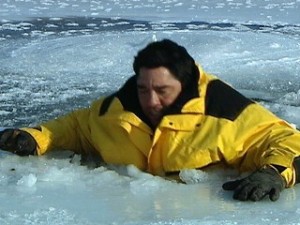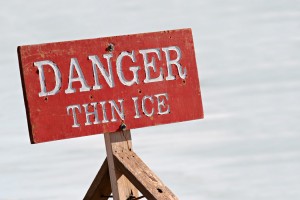- You can’t always tell the strength of ice simply by its look, its thickness, the temperature or whether or not it is covered with snow.
- Clear ice that has a bluish tint is the strongest. Ice formed by melted and refrozen snow appears milky, and is very porous and weak.
- Ice covered by snow always should be presumed unsafe. Snow acts like an insulating blanket and slows the freezing process. Ice under the snow will be thinner and weaker. A snowfall also can warm up and melt existing ice.
- If there is slush on the ice, stay off. Slush ice is only about half as strong as clear ice and indicates the ice is no longer freezing from the bottom.
- Be especially cautious in areas where air temperatures have fluctuated. A warm spell may take several days to weaken the ice; however, when temperatures vary widely, causing the ice to thaw during the day and refreeze at night, the result is a weak, “spongy” or honeycombed ice that is unsafe.
- The DNR does not recommend the standard “inch-thickness” guide used by many anglers and snowmobilers to determine ice safety. A minimum of four inches of clear ice is required to support an average person’s weight on the ice, but since ice seldom forms at a uniform rate it is important to check ice thickness with a spud and ruler every few steps.
Tag: winter ice safety
Winter Ice Safety
It is important to remember that there is no such thing as 100% safe ice! Many factors affect the strength of ice besides thickness.
- Thawing and refreezing
- Pockets of air can form under the ice on lakes where the water levels are raised and lowered by flood control.
- Ice seldom freezes uniformly
- The insulating effect of snow slows down the freezing process
- Ice formed over flowing water and currents is often dangerous
- Schools of fish moving warm water up can open holes in the ice
Here are some guidelines for determining if the ice is safe:
- 4” of new clear ice is the minimum thickness for travel on foot
- 5” is the minimum for snowmobiles and ATVs
- 8”-12” for cars or small trucks
- Check with a local resort or bait shop for known thin ice areas.
- Refrain from driving on ice whenever possible.
A minimum of five inches of ice is recommended for safe enjoyment of ice skating, ice fishing, ice boating and snowmobiling on state park lakes. However, even if the ice is several inches thick, ice-covered water is never completely safe.
via Winter Ice Safety.


